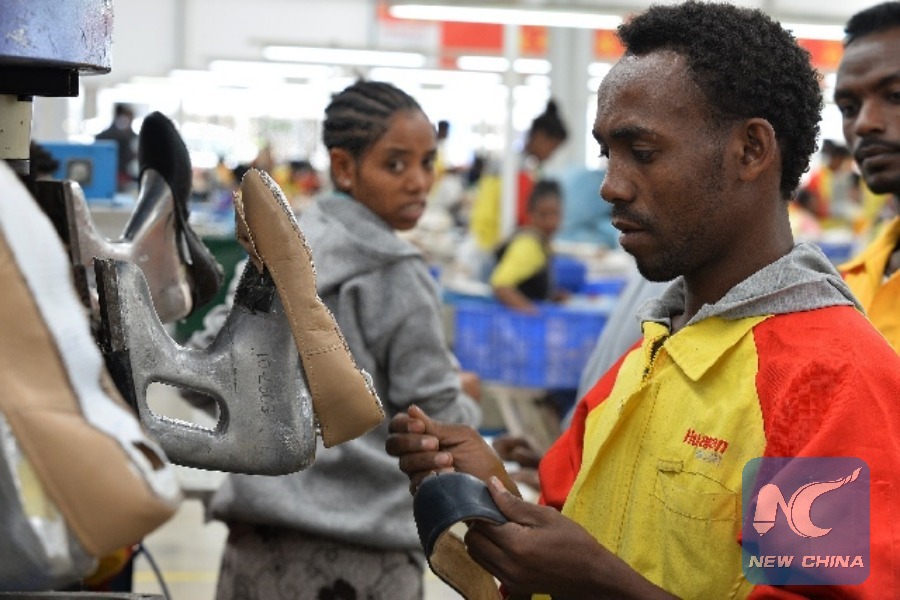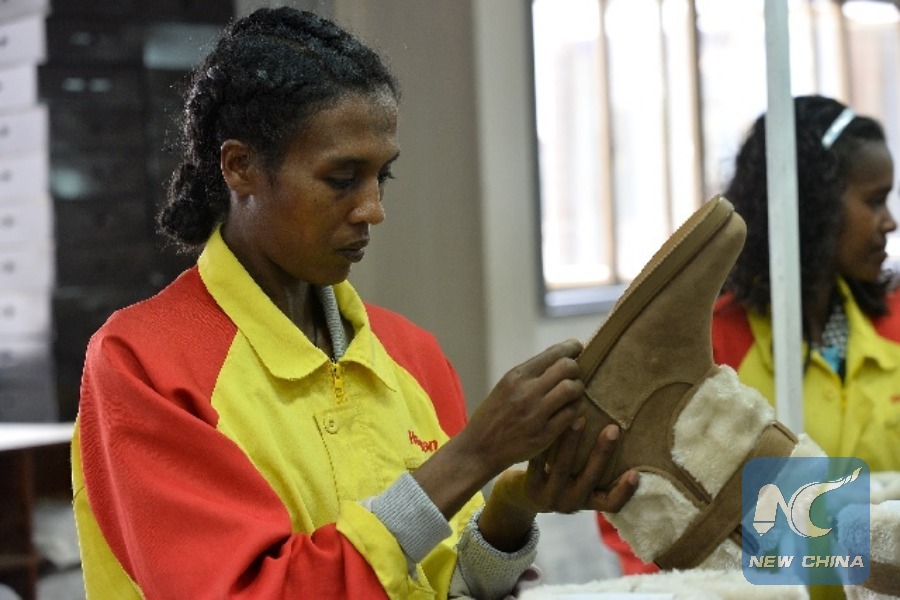by Xinhua writer Gao Wencheng
ADDIS ABABA, March 31 (Xinhua) -- The town of Dukem, just 35 km south of capital Addis Ababa, has earned a fame on the world export map for its "Made in Ethiopia" shoes.
The once-farming town began to see a surge in manufacturing in 2010, when Ethiopia's first industrial park was opened here. Built with Chinese investment, the 40-hectare Eastern Industrial Zone is where Huajian, a Chinese shoemaker producing for brands like GUESS, Calvin Klein, Nina and other branded items, set up its factory in 2011.
It was followed by a second Huajian factory in August 2016 in the firm's own industrial park on the outskirts of the capital.
Huajian began building its light industrial park in 2015 due to the China-proposed Belt and Road Initiative, which has been hailed by the Ethiopian government as farsighted with global significance.
Today, the two Huajian factories together provide direct jobs to more than 7,000 Ethiopians.

A laborer works at Huajian factory, south of Addis Ababa, capital of Ethiopia, July 19, 2017. (Xinhua/Michael Tewelde)
ETHIOPIANS CHASING DREAMS IN CHINESE FACTORIES
Demis Degef, 27, tells how the factories changed the course of his career.
In 2012, Degef graduated from Addis Ababa University with a degree in clinical nursing but could not find a job. He later chose to join Huajian and learn shoe-making.
His college education and English language skills came in handy. Two months later, he became a team leader. After a year and a half, he found himself in Dongguan city, where Huajian sent him to its base back in south China for training. Now he is in a management position.
Degef remembered how he worked to improve his Chinese in China. "Every night after I returned to the dormitory, I listened to online Chinese conversation in bed," he said. When the training was over, he was ranked top among his peers.
Today, Degef speaks fluent Chinese. In 2017, he was appointed head of a workshop at Huajian's second factory in Ethiopia and his salary was 20 times what he got five years ago.

A laborer works at Huajian factory, south of Addis Ababa, capital of Ethiopia, July 19, 2017. (Xinhua/Michael Tewelde)
To date, Huajian has selected more than 500 Ethiopian employees for a training of six months to two years in China. They are expected to be the future managers of Huajian in their home country.
For 27-year-old Esrael Etefa, the Chinese firm has changed local people's working ethics. "For many Ethiopians, it does not matter if we are late for work. If we do not feel like working, we just ask for a leave," he said.
"However, while working in the factory, I gradually realized that if we are casual about work, we will damage the company's productivity, which will also affect our own incomes," Etefa said.
Etefa has a Chinese name -- "Fazhan," or development. "I like the name because of its meaning," said Etefa, "The company provides a platform for many of our people to develop ourselves."

A laborer works at Huajian factory, south of Addis Ababa, capital of Ethiopia, Oct. 18, 2016. (Xinhua/Michael Tewelde)
ETHIOPIA PIONEERS ALONG BELT AND ROAD
Few had expected Ethiopia to become a manufacturing base. Today it is embracing a labor-intensive, export-oriented manufacturing industry catering to developed markets.
Every year, in the two Huajian factories alone, about 5 million pairs of shoes, made for brands like Marc Fisher, Coach and UGG, and labeled "Made In Ethiopia," are shipped to the U.S. and European markets, fetching the East African nation some 31.08 million U.S. dollars in foreign exchange earnings in 2017.
Following China's experience, Ethiopia now plans to increase the number of its industrial parks to 15 by June 2018 as part of its efforts to boost manufacturing and export.
Within the framework of the Belt and Road Initiative, China has also built and financed a 4.2-billion-dollar Ethiopia-Djibouti electrified rail line to boost Ethiopia's industrial exports.
"The industrial parks lying on the path of the rail line will be a game changer for both countries and in general for the region, enhancing economic transformation and easing transportation of goods," said Ahmed Shide, Ethiopian transport minister.

Laborers work at Huajian factory, south of Addis Ababa, capital of Ethiopia, July 19, 2017. (Xinhua/Michael Tewelde)
"Africa has abundant labor resources. More importantly, the locals love to work here very much," Zhang Huarong, Huajian founder and chairman, said.
For the Huajian case, it is an integration of China's technique advantages with Ethiopia's low-cost production advantages, achieving win-win cooperation, he added.
At the close of the day, in the Chinese shoe-making factories Ethiopian workers have finished their work and are getting ready to go home, laughing and chatting with co-workers, confident about their future.
"Since I began working at Huajian, I have my own house through my own efforts," said the buoyant Degef, "The life of my whole family is secure now."
In his book "The Quest for Prosperity: How Developing Economies Can Take Off," Justin Yifu Lin, former senior vice president and chief economist of the World Bank, said, "The quick success of Huajian Shoe Factory in Ethiopia shows that the (Chinese) recipe can also work in other developing countries."
Ethiopia, which lacks capacity to improve transport facilities and business environment for the whole country, can build industrial parks to attract investments, Lin said.

Laborers work at Huajian factory, south of Addis Ababa, capital of Ethiopia, July 19, 2017. (Xinhua/Michael Tewelde)
CHINA'S PROPOSALS FOR A SHARED FUTURE
The industrial parks in Ethiopia are part of the story of how China has also built overseas trade and economic cooperation zones in Cambodia, Vietnam, Pakistan, Zambia, Egypt, Nigeria and elsewhere.
These zones have earned a reputation as "catch-up vehicles," assisting less-developed economies to stimulate their competitiveness, and consequently, development.
Chinese companies have built 75 zones for economic and trade cooperation in 24 countries along the Belt and Road routes, contributing more than 2.2 billion dollars of taxes and creating almost 210,000 local jobs by the end of 2017, according to official figures.
Proposed by Chinese President Xi Jinping in 2013, the Belt and Road Initiative aims to achieve policy, infrastructure, trade, financial and people-to-people connectivity along and beyond the ancient Silk Road trade routes, thus building a new platform for international cooperation to create new drivers of growth.

A laborer works at Huajian factory, south of Addis Ababa, capital of Ethiopia, July 19, 2017. (Xinhua/Michael Tewelde)
With the advance of the initiative, China can help other developing countries eliminate development bottlenecks and introduce a "blood making" mechanism for their sustained development, said Lin.
A large number of projects along the routes are well underway, boosting the economic and social development of the participating countries.
For example, China is building more than a dozen power stations for Pakistan, the largest of which is supplying electricity to tens of millions of Pakistanis. When all of them are completed, power cuts and shortages are expected to be a thing of the past in the South Asian country.
China is also joining hands with France to build a nuclear power plant at Hinkley Point in Britain, a shining example of high-tech cooperation within the framework of the initiative.
(Xinhua reporter Wang Shoubao in Addis Ababa also contributed to the story.)

